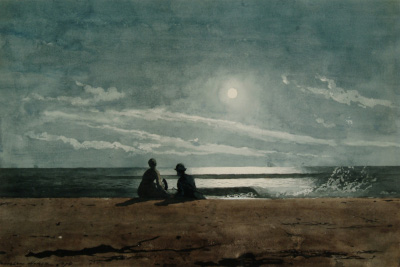 Buy Art Prints Now
Buy Art Prints Nowfrom Amazon
* As an Amazon Associate, and partner with Google Adsense and Ezoic, I earn from qualifying purchases.
Artist Winslow Homer captured moonlit landscapes and seascapes several times within his career. He was known to rush off out of his house just at the right moment in order to work within this very particular lighting.
The item in front of us here dates from 1874 and it would be another decade before seascapes dominated the artist's oeuvre. This memorable composition features two figures sat in the foreground, looking out across the sea during an intimate moment. The light is in transition, with some bright areas, whilst others are heavily shadowed. A flick or water splashes to the right hand side, but otherwise things look fairly calm. Homer allows the top half of the scene to be given to the sky, with only a few clouds visible within this relaxing atmosphere. The sea itself is only afforded a small slither of dark blue, with the sandy beach lifted up from a mound, on which the two figures sit. They are mere silhouettes, but we can make out that this is a gentleman and lady, perhaps a romantic couple. There is a great simplicity to this piece, in which the artist avoids over complicated a piece that works well as it is.
Moonlight is known to be within the collection of the Arkell Museum and was produced using watercolours, after some initial touches of a graphite pencil. Homer would typically draw out the main forms of his piece before adding the watercolours over the top. The opaque nature of this medium meant that the original lines would often show through from below, and this was entirely deliberate. Moonlight is dated to around 1874 at which point Homer was navigating his mid to late thirties. This was an important period in his development as he was still finding his chosen style and direction, having worked as a commercial illustrator previously. He took to both oils and watercolours, appreciating the different attributes that they could bring to his work. His interest in landscape and seascape art slowly built up over time and eventually became the dominant genres within his oeuvre.
The artist would continue his use of moonlight within other related paintings such as Moonlight, Wood Island Light and a number of others. He was perhaps inspired in part by the work of the French Impressionists who would study the effects of light in great depth, although he rarely acknowledged the influence of European art on his work. Homer wanted to allow American artists to concentrate on their native land, and create bodies of work which felt exclusive to the country. He would help the country to build its own cultural identity and that was perhaps the biggest legacy from his career. Collectors and the public would now be enthused by American art and wanted it to reflect their own lives, rather than duplicating what had already been done abroad. Homer was a strong character who continued along this path, eventually achieving success, though he did also travel abroad for inspiration from time to time.



